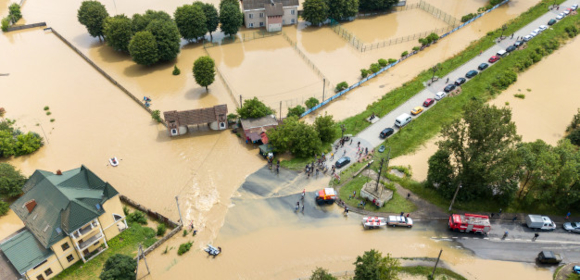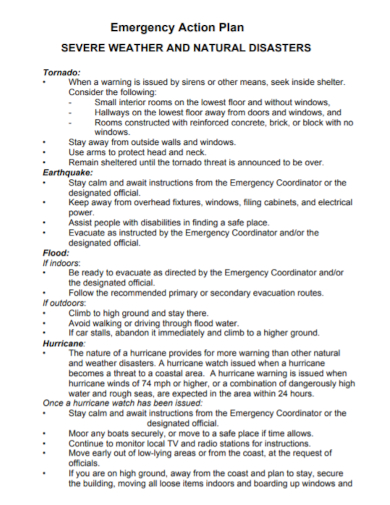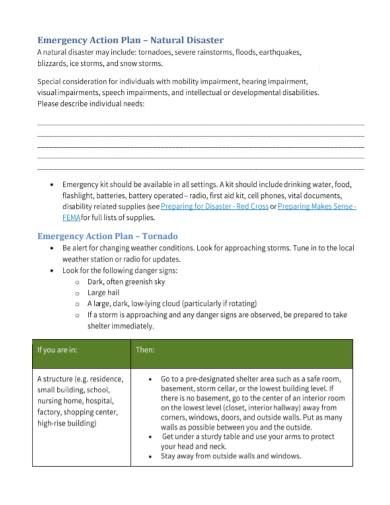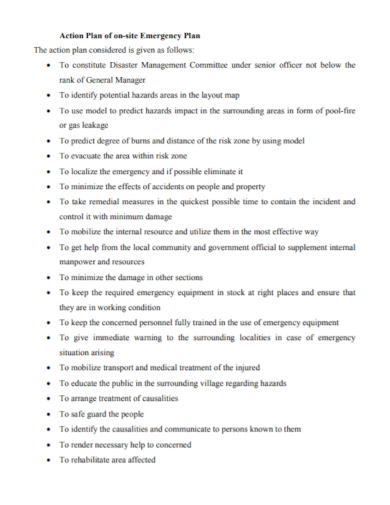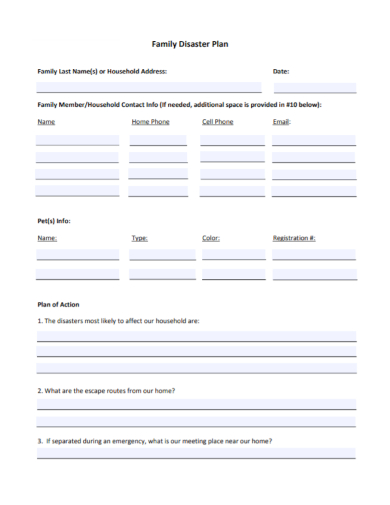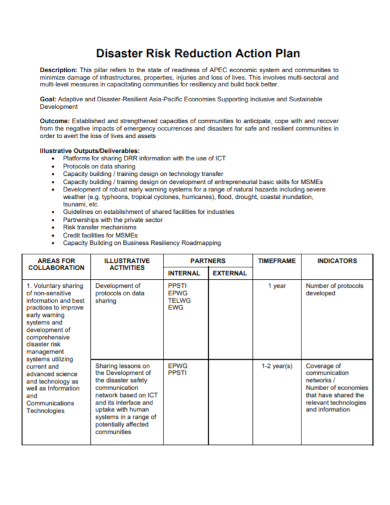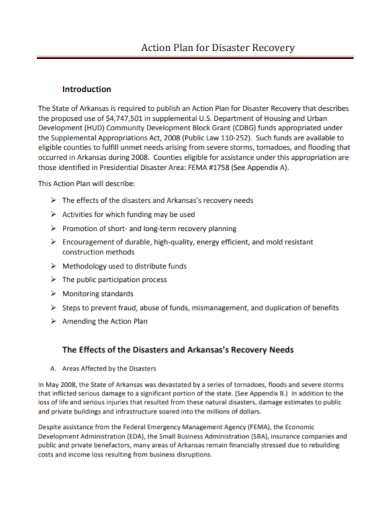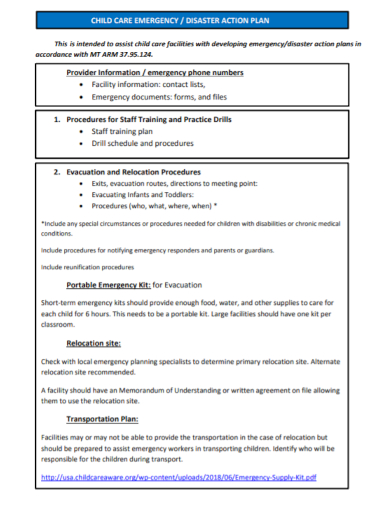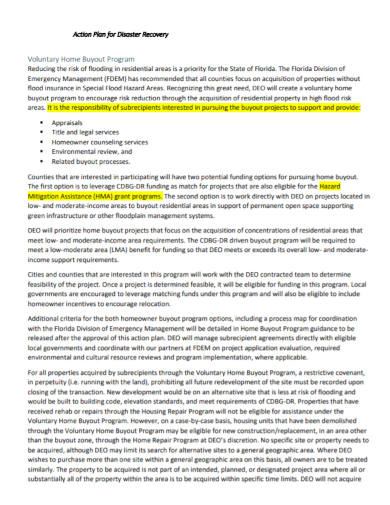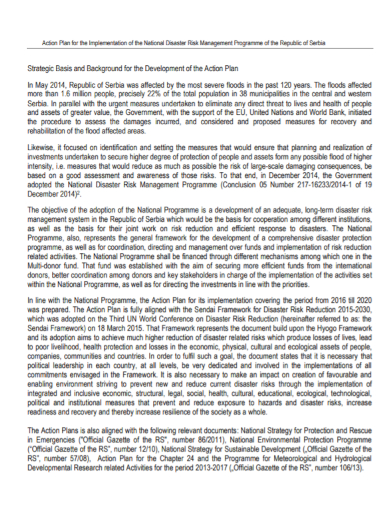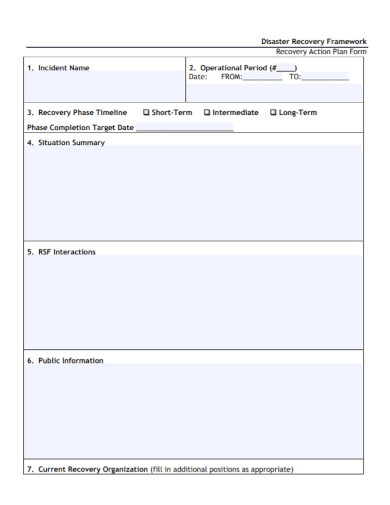There will always be natural disasters wherever you go. They are inevitable. Nobody can prevent them from happening and the only thing that authorities and government agencies can do is to alert the people of an upcoming disaster. Most disasters can do so much damage and destruction to properties and lives and they have an enormous negative impact on the communities, and businesses that were hit by the disaster. Even though people can’t stop natural disasters from happening, people can prepare on facing these occurrences. All they need to do is have a great plan and protocol to follow whenever a disaster strikes and post-disaster event. Read the article to find out how to make a disaster action plan.
10+ Disaster Action Plan Samples
1. Natural Disaster Emergency Action Plan
2. Disaster Emergency Action Plan
3. Disaster Management Action Plan
4. Family Disaster Action Plan
5. Disaster Risk Reduction Action Plan
6. Disaster Recovery Action Plan
7. Child Care Disaster Action Plan
8. Disaster Recovery Program Action Plan
9. Disaster Strategic Development Action Plan
10. Disaster Recovery Action Plan Form
11. Disaster Emergency Management Action Plan
Risks Associated with Disasters
When disasters strike, they often destroy everything that is around them. From trees and crops to buildings, homes, cars, assets, and even injury; the damage can be irreparable and irreplaceable especially if the disaster is too strong. This could cost thousands of dollars and for some, it’ll be difficult to go back to normal. Furthermore, it can affect the supply chain of products such as necessities so people are usually desperate for food, water, shelter, and other necessities after the disaster struck.
How to Make a Disaster Action Plan
1. Gather information
Know what types of disasters or hazards are likely to happen in your area that affects greatly your home and your community. Find out the warning signs and how you should prepare for them. Make sure to familiarize yourself with the warning signs just in case a disaster might come.
2. Keep Your Important Documents Safe and Set Aside an Emergency Fund
Don’t wait for the disaster to happen to do an action that will preserve your valuables. Keep a list of important contacts, phone numbers, and emergency numbers. Stick the number on your refrigerator door and cabinets. Save these numbers on your phones. Don’t forget to protect all your important documents by keeping them in a safe and secure place to avoid these documents getting damaged. Have a backup for your important documents. Scan the documents and save them on your computer and in your backup apps just in case your computer breaks down.
Part of being ready for every disaster is keeping an emergency fund. Set aside some cash and keep it in a secure place where no one can touch it. This is a wise financial move because during emergencies you may not be able to obtain money right away so having set aside some cash can help you pay for necessities right away.
3. Make a Plan On What to Do When Disaster Strikes
Your disaster action plan must be detailed on how you will act when disaster hits. Don’t forget to include plans for your pets. You and your family members must know how you can contact each other if you are at work, school, or in any other location. Make sure you give emergency numbers to all family members. When disasters like typhoons, blizzards, floods, or cyclones are coming, stay alert for emergency broadcasts on radios, TVs, weather alerts, and news sources on the internet.
Make a family emergency supply kit just in case the area outside is off-limits and you can’t go out to buy food and necessities. Your emergency kit must have 3 or more days of supplies such as food, water, medicine, first aid, and other tools you need. For sudden emergencies such as fires, tornadoes, or earthquakes, choose a post-hazard meeting place for your family in case if you weren’t home when the disaster struck. Learn where the evacuation shelters are located.
FAQs
What are the main components of a disaster plan?
The main components of disaster planning in emergency management are mitigation, preparedness, response, and recovery.
What are emergency situations?
Anywhere can be a potential place for disaster and emergency situations to strike. Some of the identified emergency situations are workplace hazards, natural disasters, restaurant and catering hazards, environmental hazards, and manmade hazards.
What are barriers to action?
When an emergency strikes, it’s highly crucial to attend to resolve it right away to prevent it from escalating. However, for responders such as ambulance responders, firefighters, policemen, there are a few barriers that prevent or delay responding in the situation. These barriers are the presence of bystanders in streets, sidewalks, walkways, etc., uncertainty about the casualty or the nature of injury or illness, and fear of doing something wrong resulting in uncertainties.
When making your action plan for disaster, ensure that you discussed it with your family members. Try to have a dry run of the plans you’ve come up with to help your family know the things they need to do and to also tweak some of the actions you’ve decided before just in case if they weren’t practical to do. To help you get started on making your disaster action, refer to our sample action plan templates! They are free so you can download as many as you like!
Related Posts
FREE 10+ Mentoring Action Plan Samples in MS Word Google ...
FREE 8+ Sample HR Action Plan Templates in PDF
FREE 10+ Sample Personal Action Plan Templates in PDF MS Word
FREE 8+ Sample Career Action Plan Templates in PDF
FREE 35+ Sample Action Plan Templates in MS Word
FREE 30+ Sample Action Plan Work Sheet Templates in MS Word ...
FREE 8+ Sample Smart Action Plan Templates in MS Word Google ...
FREE 14+ Sample Corrective Action Plan Templates in MS Word ...
FREE 10+ Team Action Plan Samples in PDF MS Word
FREE 7+ Sample Curriculum Action Plan Templates in PDF
FREE 9+ Sample Asthma Action Plan Templates in MS Word PDF
FREE 15+ Action Plan Templates in Google Docs MS Word | Pages ...
FREE 9+ Sample Incident Action Plan Templates in PDF MS Word
FREE 10+ Research Action Plan Samples in PDF MS Word
FREE 8+ Sample School Action Plan Templates in MS Word PDF
